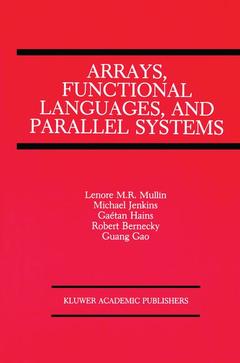Description
Arrays, Functional Languages, and Parallel Systems, Softcover reprint of the original 1st ed. 1991
Coordinator: Restifo Mullin Lenore M.
Language: English
Subject for Arrays, Functional Languages, and Parallel Systems:
Keywords
Calc; DEX; Haskell; Jenkins; algorithms; calculus; computer; design; formal methods; function; functional; presentation; processor; programming; scientific computing
Publication date: 09-2012
319 p. · 15.5x23.5 cm · Paperback
319 p. · 15.5x23.5 cm · Paperback
Description
/li>Contents
/li>
During a meeting in Toronto last winter, Mike Jenkins, Bob Bernecky and I were discussing how the two existing theories on arrays influenced or were in fluenced by programming languages and systems. More's Army Theory was the basis for NIAL and APL2 and Mullin's A Mathematics of A rmys(MOA) , is being used as an algebra of arrays in functional and A-calculus based pro gramming languages. MOA was influenced by Iverson's initial and extended algebra, the foundations for APL and J respectively. We discussed that there is a lot of interest in the Computer Science and Engineering communities concerning formal methods for languages that could support massively parallel operations in scientific computing, a back to-roots interest for both Mike and myself. Languages for this domain can no longer be informally developed since it is necessary to map languages easily to many multiprocessor architectures. Software systems intended for parallel computation require a formal basis so that modifications can be done with relative ease while ensuring integrity in design. List based lan guages are profiting from theoretical foundations such as the Bird-Meertens formalism. Their theory has been successfully used to describe list based parallel algorithms across many classes of architectures.
1 Arrays and the Lambda Calculus.- 2 Compiling APL.- 3 Acorn Run-Time System for the CM-2.- 4 Compiling Issues of Monolithic Arrays.- 5 Arrays in Sisal.- 6 Falafel: Arrays in a Functional Language.- 7 Arrays in Haskell.- 8 Array Theory and Knowledge Representation.- 9 A Parallel Intermediate Representation Based on Lambda Expressions.- 10 Arrays in Fidil.- 11 Structured Data-Types in the Reduction System ?-RED.- 12 Psi, The Indexing Function: A Basis for FFP with Arrays.- 13 Genotype-A Pure Functional Array Language.- 14 A Comparison of Array Theory and A Mathematics of Arrays.- 15 Alternative Evaluation of Array Expressions.- 16 Matrix Inverion in 3 Dimensions.- 17 Fuzzy Inference Using Array Theory and Nial.
© 2024 LAVOISIER S.A.S.




